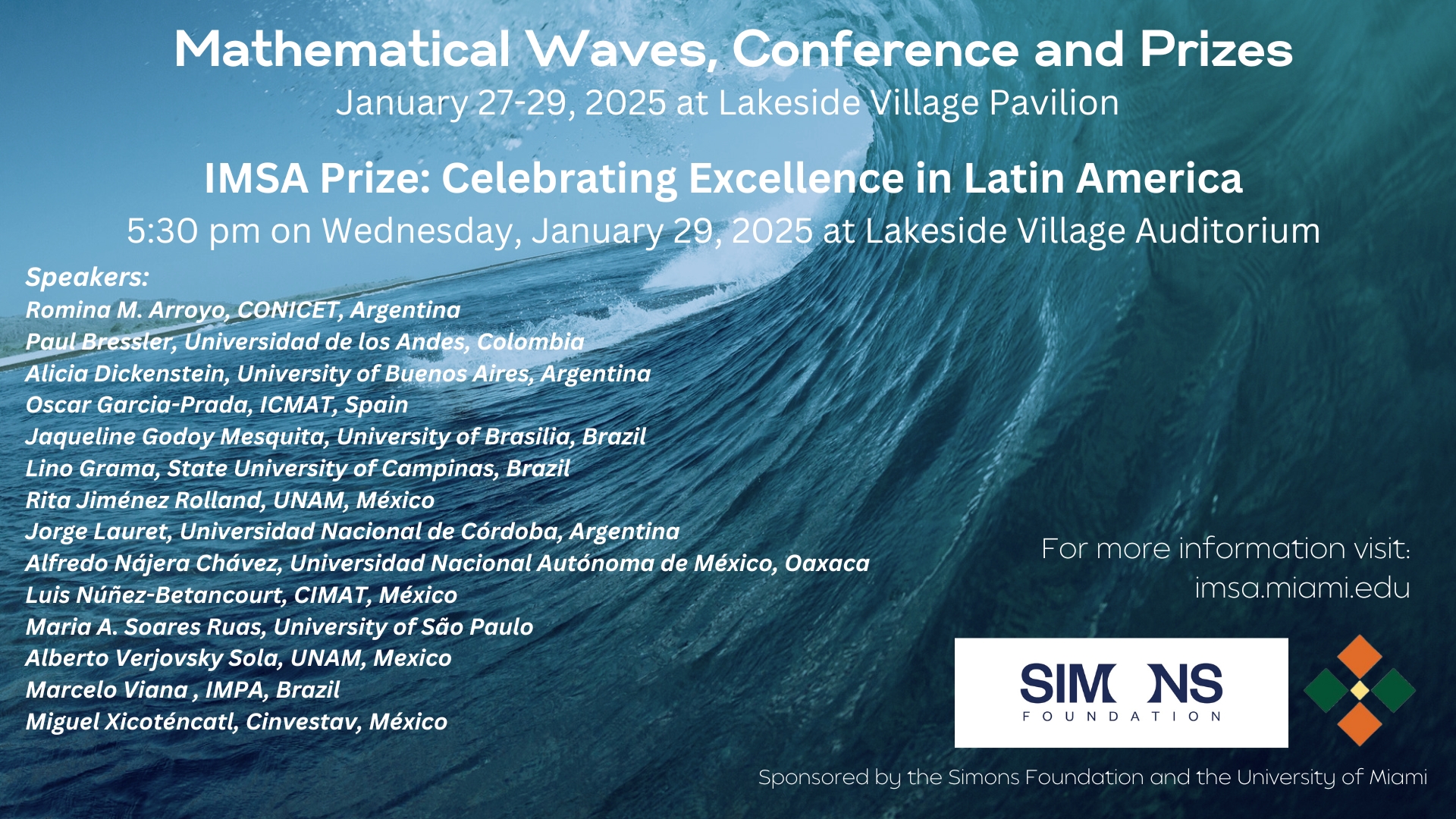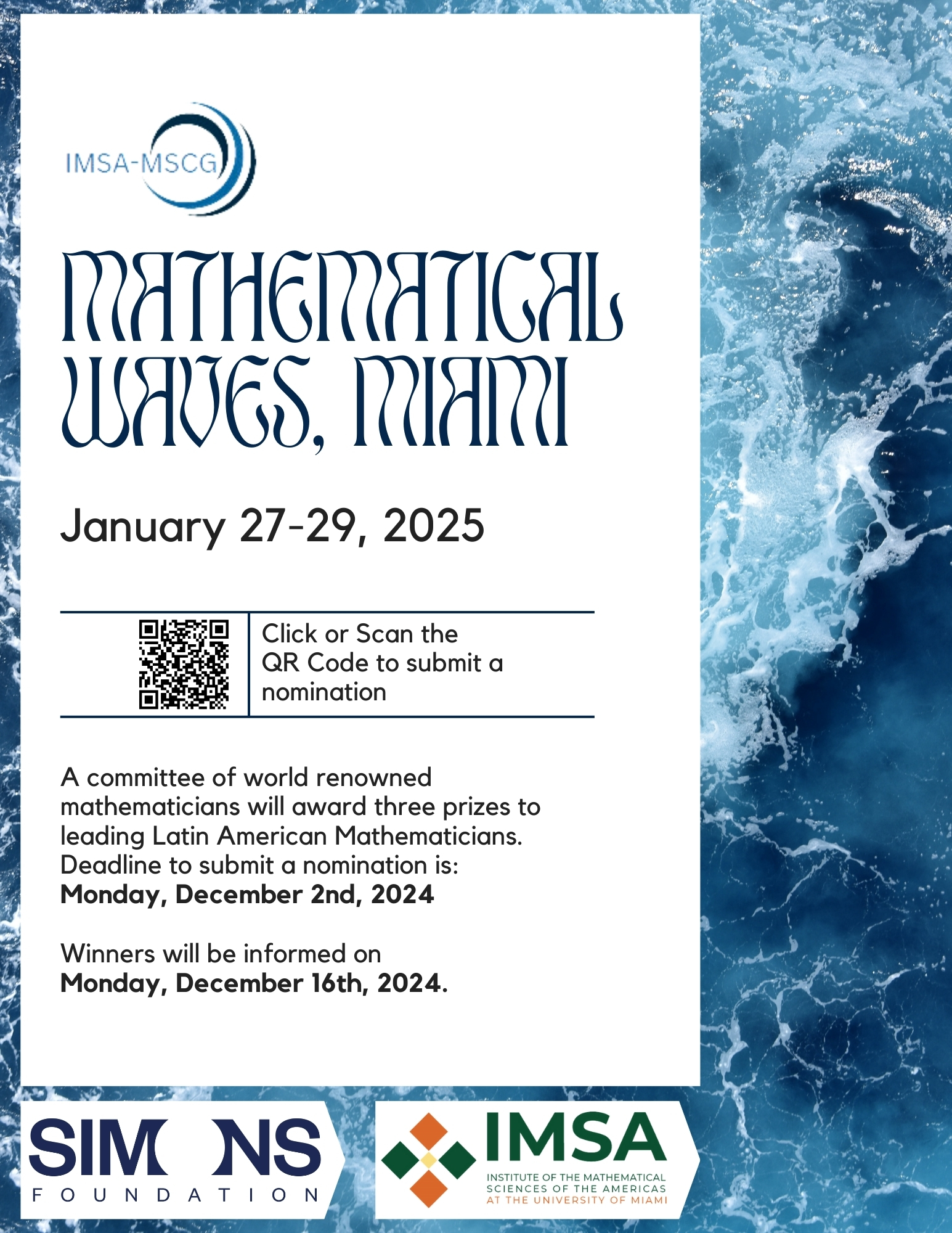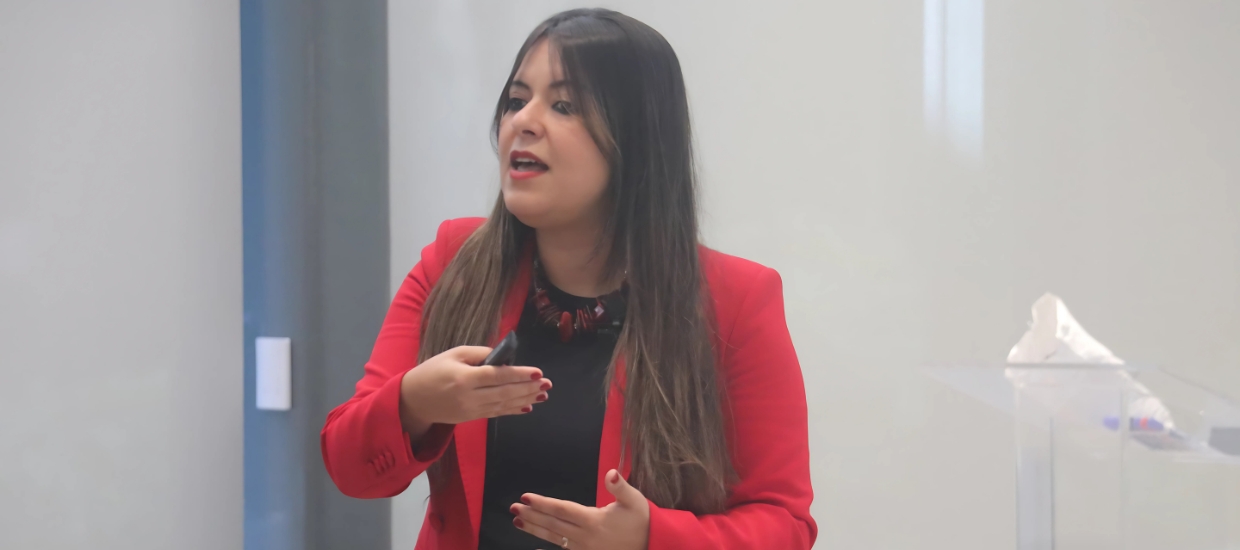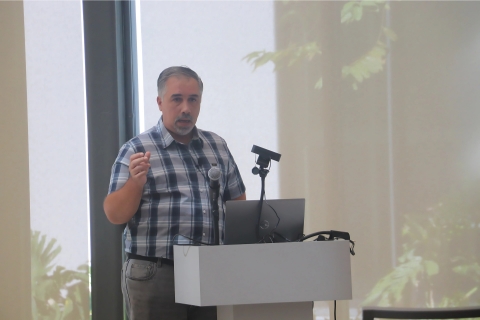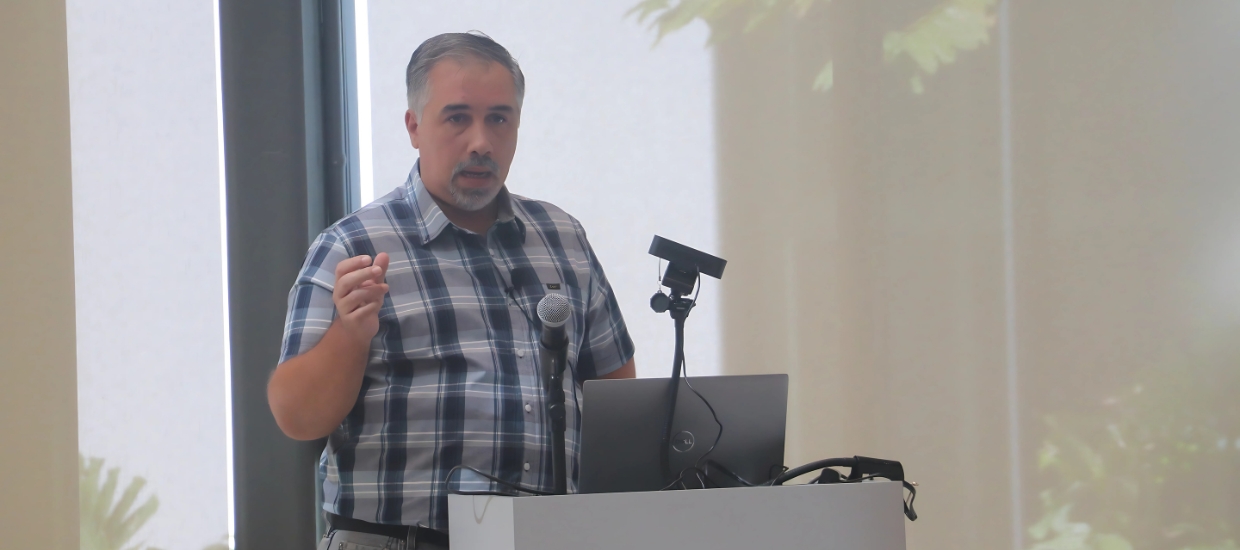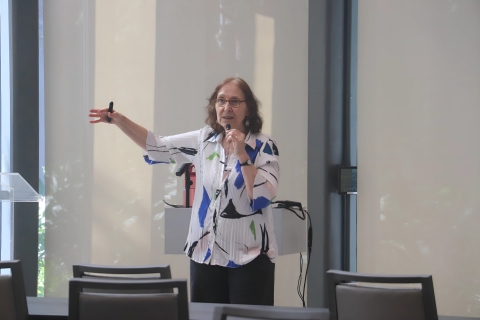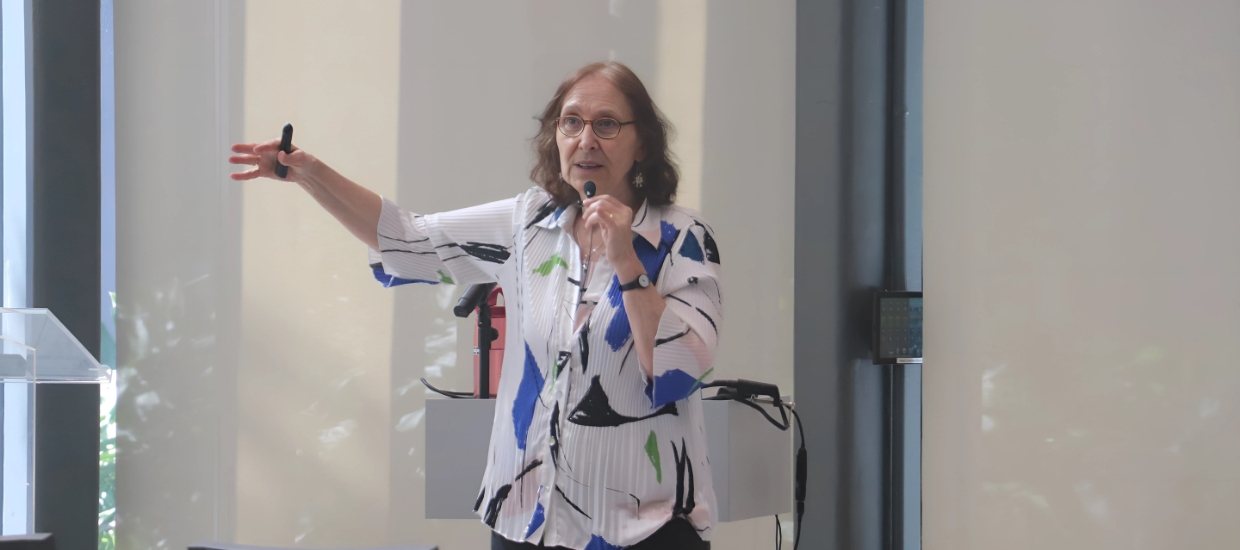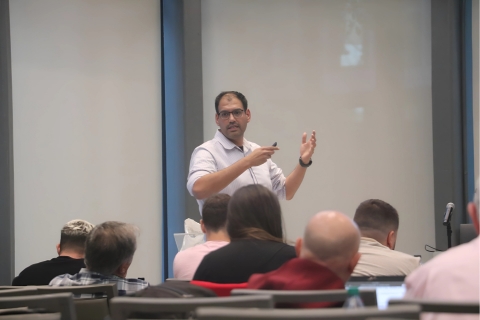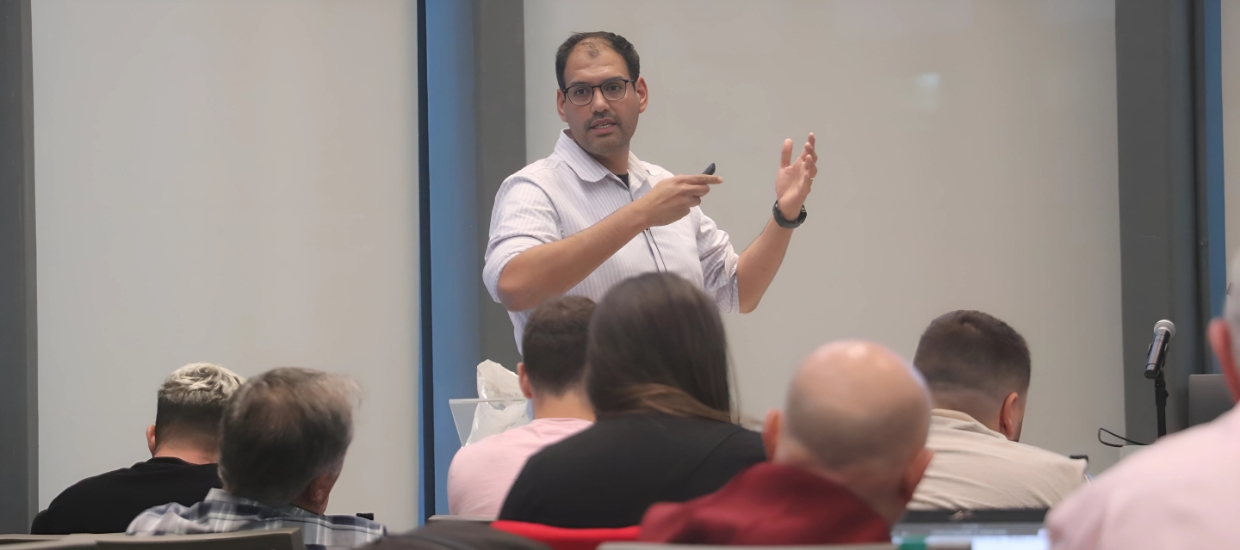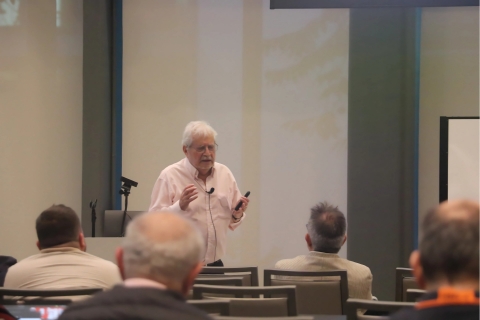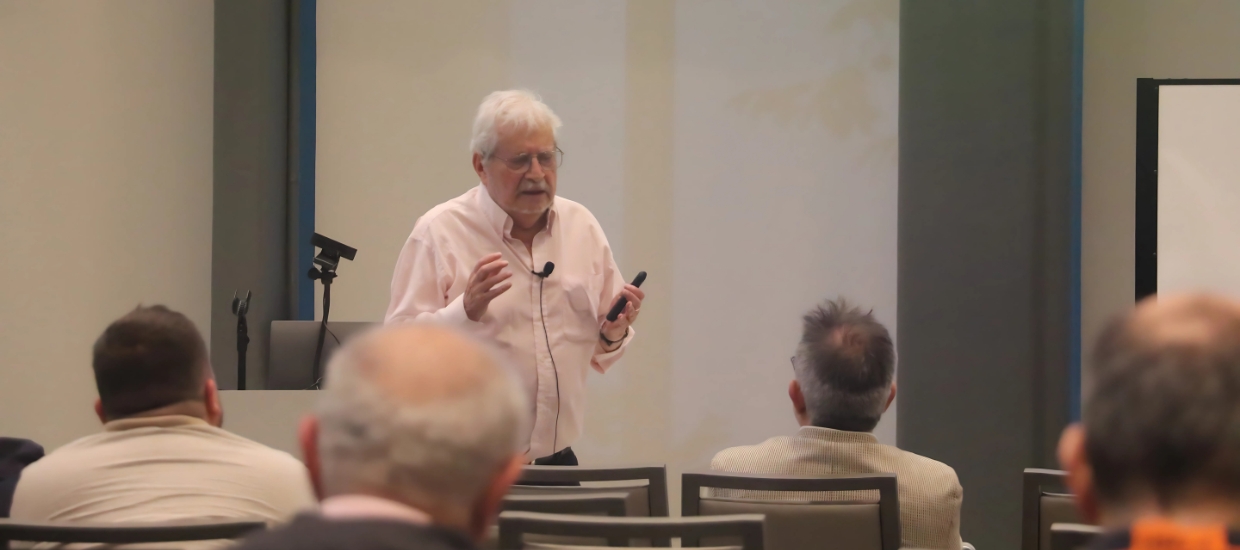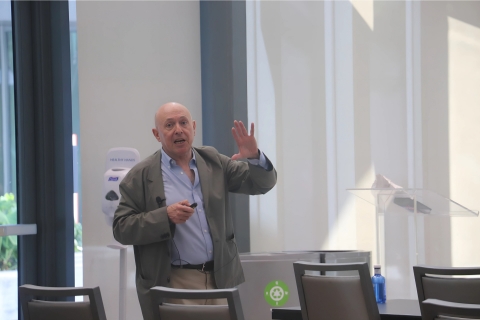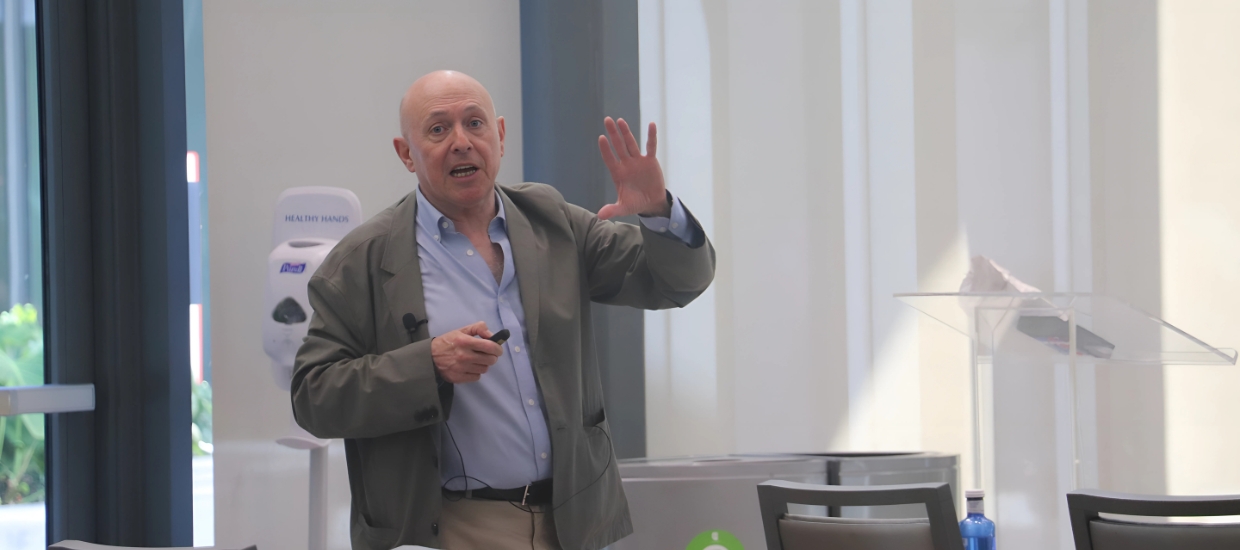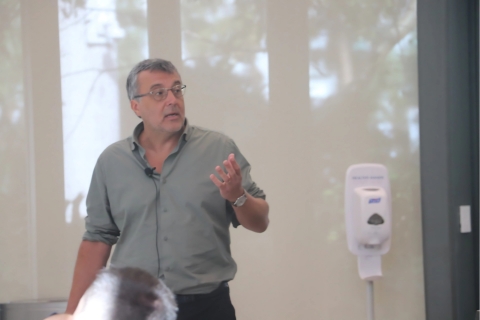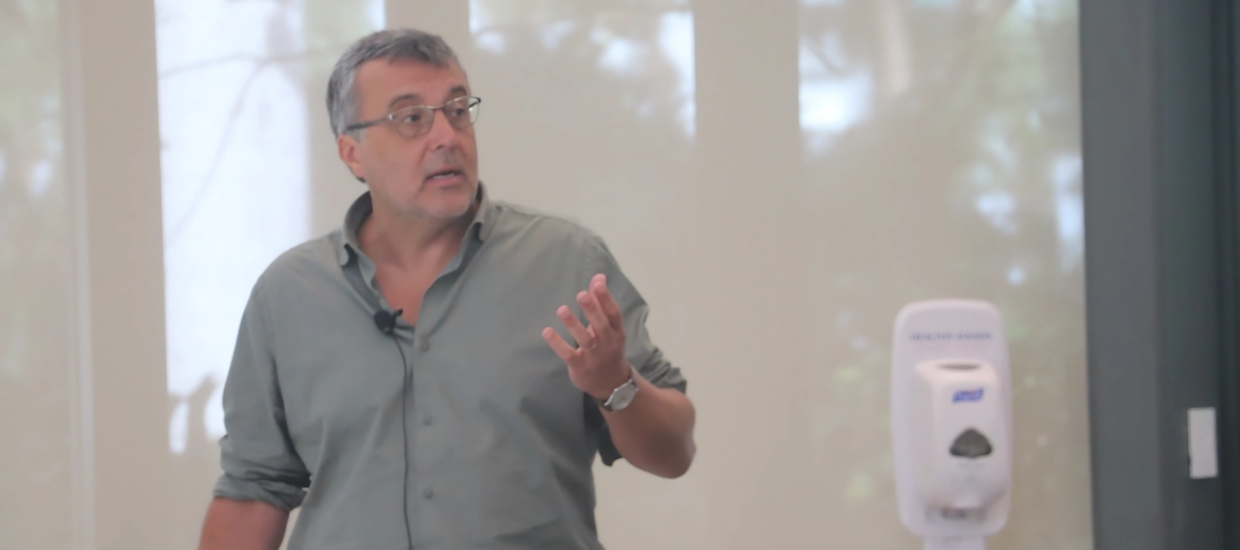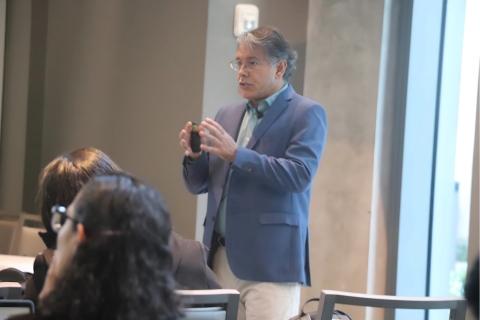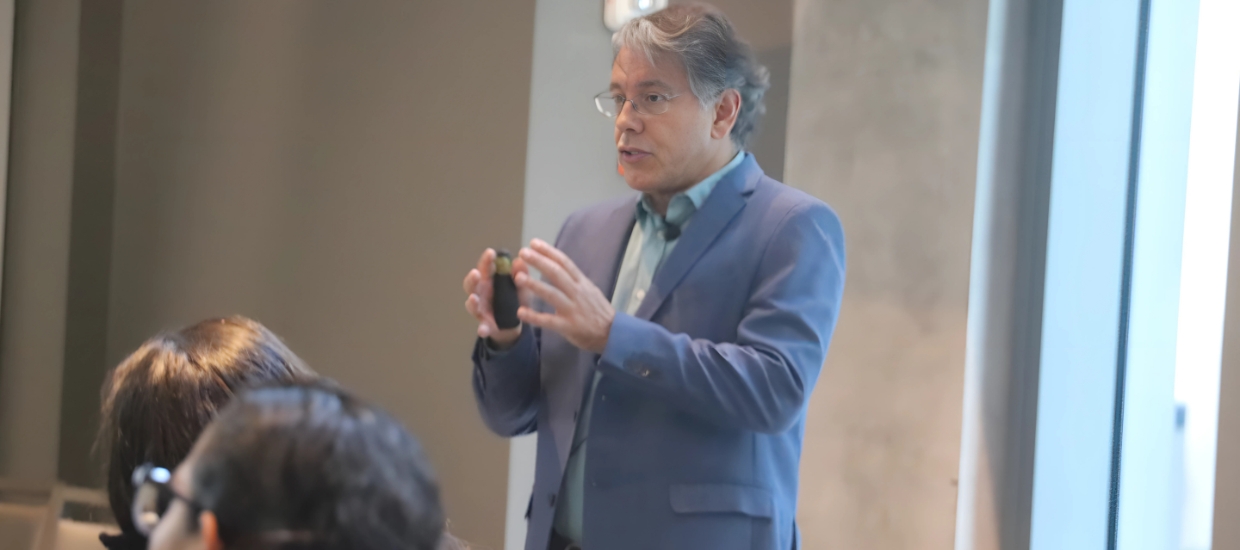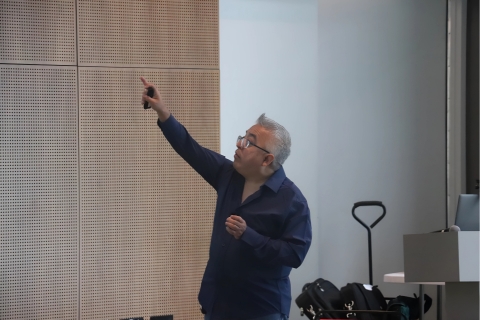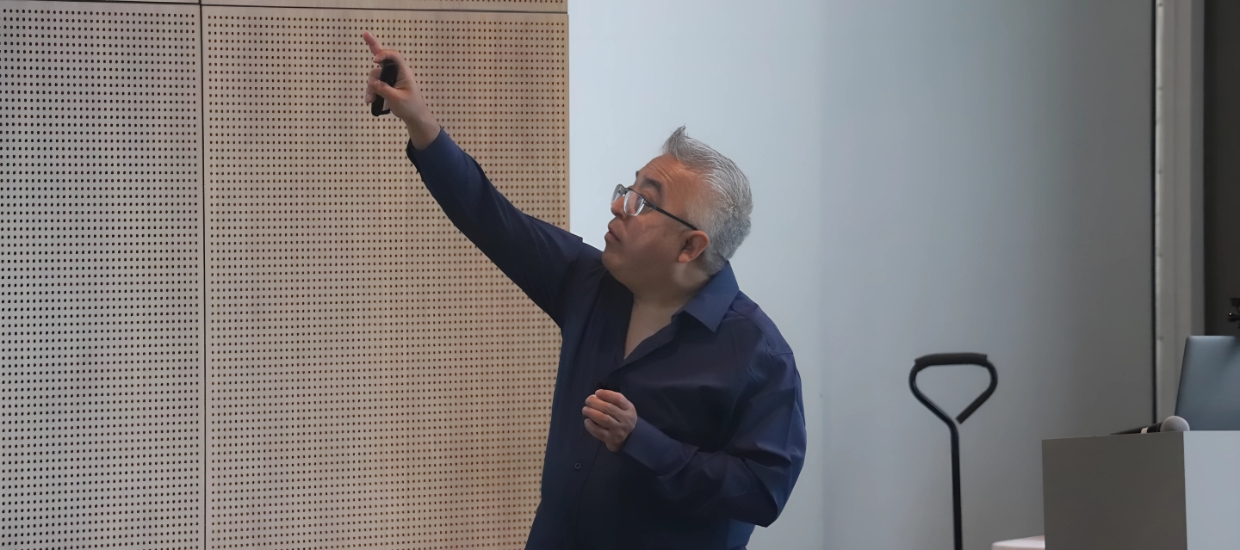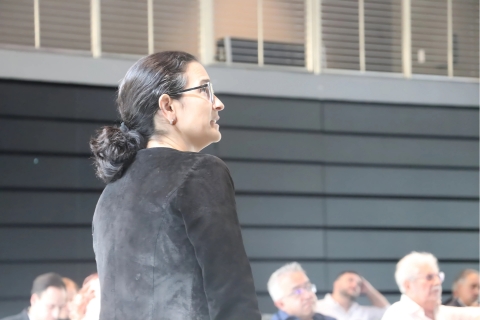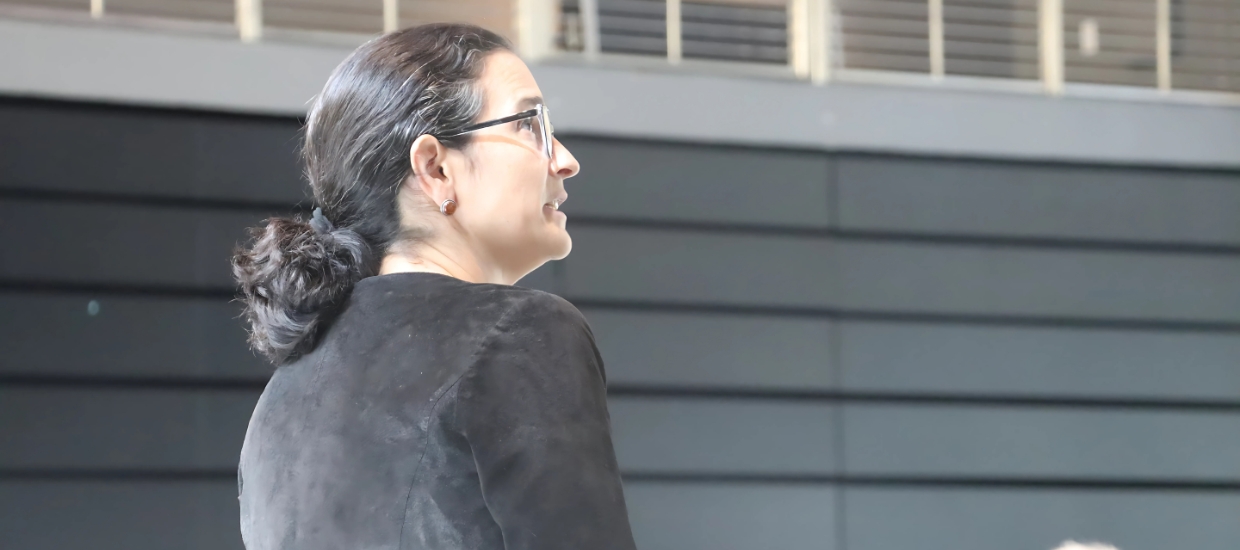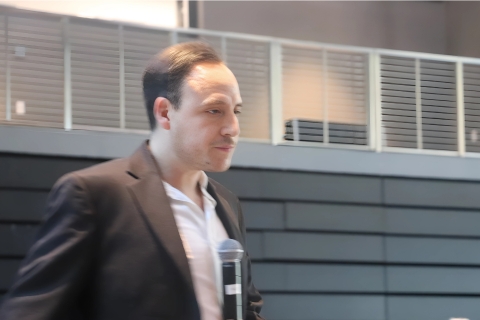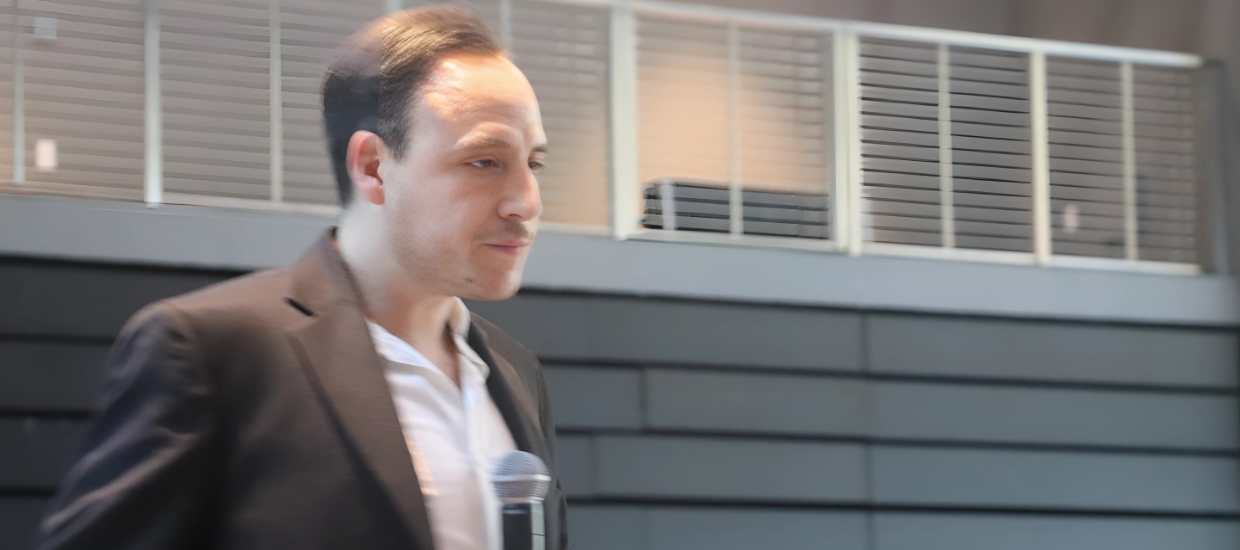Dates: January 27-29, 2025
Location: Lakeside Village Pavilion, 1280 Stanford Dr, Coral Gables, FL 33146
Live Video Available via Zoom
To register, please click here .
This is the conference of an IMSA series of conferences. The goal of these conferences is to demonstrate recent developments in Mathematics and promote Latin American Mathematicians
Schedule
Monday, January 27, 2025
| 10:00am |
Jaqueline Mesquita, University of Brasilia, Brazil: A competitive chemostat model with time-dependent delays
In this work, a non-autonomous chemostat model with time-dependent delays modelling $n$ microorganisms in competition is derived and studied. Under very mild general conditions on the coefficients and time-varying delays, we investigate the extinction of all the species and, in the case of a periodic system, the existence of nontrivial and nonnegative periodic solutions. For the model with a simple microorganism, a criterion for the uniform persistence is established, which also implies the global attractivity of any positive solution. In this way, a criterion for the existence, uniqueness and global attractivity of a positive periodic solution is derived. These results largely generalize and enhance recent achievements in the literature. This is a joint work with Teresa Faria. Video
|
| 11:30am |
Lino Grama, CAMPINAS, Brazil: New look at Milnor spheres
In talk we will explore the interplay between Spherical T-duality, exotic spheres, and the generalized log transform, highlighting new connections in geometric topology and complex geometry. Spherical T-duality extends the classical T-duality by replacing the role of the circle group $\mathrm{U}(1)$ with the 3-sphere $\mathrm{S}^3$ or the group $\mathrm{SU}(2)$, relating $\mathrm{SU}(2)$ bundles equipped with degree-7 cohomology cocycles. A remarkable class of examples involves the 7-dimensional homotopy spheres $\Sigma^7$, whose product with $\mathrm{S}^1$ exhibits phenomena such as distinct holomorphic structures transported via spherical T-duality, which contrasts with classical Hopf manifolds like $\mathrm{S}^3 \times \mathrm{S}^1$.
Building on this framework, we introduce the generalized log transform, a tool extending classical techniques from 4-dimensional elliptic fibrations to higher-dimensional settings. Applying this to 8-dimensional homotopy Hopf manifolds, we reveal parallels between these constructions and their lower-dimensional counterparts, providing new insights into the role of singularities and complex structures. This is joint work with Leonardo Cavenaghi and Ludmil Katzarkov. Video
|
| 2:00pm |
Alicia Dickenstein, University of Buenos Aires, Argentina: Real and sparse intersections
Models in science and engineering are frequently expressed as sets of solutions of parameterized systems of polynomial equations with fixed supports, giving rise to special families of affine algebraic varieties. However, these models are usually concerned with real solutions, or even positive real solutions, and the number of variables and parameters is often very large. This poses new challenges that existing techniques fail to overcome. I will describe some lower and upper bounds on the number of positive solutions obtained in recent years inspired by applications, and state some basic open problems.
|
| 3:30pm |
Luis Nunez-Betancourt, CIMAT, Mexico: Frobenius and Differential Operators to Measure Singularities
In 1969, Kunz showed that the Frobenius map can be used to determine whether a variety is smooth or singular. Since then, this map has been employed to classify and measure singularities. In this talk, we will focus on the F-pure threshold introduced by Takagi and Watanabe in 2004. Specifically, we will discuss geometric properties of this numerical invariant. The results presented in this talk are an application of differential operators. This is joint work with Alessandro De Stefani (Università di Genova) and Ilya Smirnov (Basque Center for Applied Mathematics). Video
|
| 4:30pm |
Alberto Verjovsky, UNAM: N-dimensional beaded necklaces and higher dimensional wild knots, invariant by a Schottky group
Starting with a smooth n-dimensional knot K in the (n+2)-sphere S^{n+2}, and a beaded n-dimensional necklace (a disjoint union of round, closed, (n+2)-balls, called the "beads") subordinated to K (i.e., with centers in S^{n+2}), we construct a wild knot with a Cantor set of wild points (i.e., the knot is not locally flat in these points).
The construction uses the conformal Schottky group acting on S^{n+2} generated by inversions on the spheres which are the boundary of the“beads”. We show that the wild knot is also fibered if K is a fibered knot. We also study cyclic branched coverings along the wild knots and show that If the wild knot bounds a wild disk (à la
Alexander) then the branch covering is homeomorphic to S^{n+2}. Video
|
Tuesday, January 28, 2025
| 10:00am |
Oscar Garcia-Prada, ICMAT, Spain: Geometry of Hodge bundles on Riemann surfaces
Given a compact Riemann surface X and a complex reductive group G, we consider the moduli space of G-Higgs bundles over X. There is a natural C*-action on this moduli space given by scaling the Higgs field. The fixed points of this action with non-zero Higgs field are called Hodge bundles since, through the non-abelian Hodge correspondence, they are in bijection with variations of Hodge structure. In this talk, I will discuss several basic aspects of the geometry of Hodge bundles, including the recently introduced Toledo invariant of a Hodge bundle and its Arakelov-Milnor bound, as well as the condition of being very stable and its relation to mirror symmetry and Langlands duality. Video
|
| 11:30am |
Jorge Lauret, Universidad Nacional de Cordoba, Argentina: The existence problem for Einstein metrics on compact homogeneous spaces
Remarkably, any closed subgroup of real matrices G is a differentiable manifold, called a Lie group, as is any quotient M=G/K, called a homogeneous space, where K is a closed subgroup contained in G.
Moreover, any inner product on the tangent space at the origin of M which is invariant by the corresponding K-action defines a Riemannian metric containing G as a subgroup of isometries, called a G-invariant metric. The peculiar mixture of this natural and simple construction promises a rich interplay between algebra, geometry and topology, which has indeed been very fruitful in the last hundred years. In this talk, we will give an overview on the following longstanding open
problems:
1) Which homogeneous spaces M=G/K admit an Einstein (i.e., of constant Ricci curvature) G-invariant metric?
2) Is such a existence weak or strong?
3) Can a given M=G/K admit infinitely many? Video
|
| 2:00pm |
Romina M. Arroyo, CONICET, Argentina: Complex and symplectic structures on almost abelian Lie groups
The study of left-invariant geometric structures on solvable Lie groups is an active field of research and several results are known in low dimensions. A particularly intriguing problem within this field is the classification of solvable Lie groups that admit left-invariant complex or symplectic structures. Although there are many contributions to the subject, it is considered a wild problem and in general it is far from being solved.
In this talk, we will focus on left-invariant complex and symplectic structures on a specific class of solvable Lie groups known as almost abelian Lie groups. We will present the classification of almost abelian Lie groups that admit left-invariant complex structures, and we will also discuss an analogous classification result for symplectic structures.
These results were obtained through collaborative work with María Laura Barberis (Universidad Nacional de Córdoba & CONICET, Argentina), Verónica Díaz (Universidad Nacional de Mar del Plata, Argentina), Yamile Godoy (Universidad Nacional de Córdoba & CONICET, Argentina) and María Isabel Hernández (CONACYT - CIMAT Mérida, Mexico). Video
|
| 3:30pm |
Paul Bressler, Universidad de los Andes, Colombia: On the signature of unimodular fans
A theorem of Leung and Reiner predicts the signature of acomplete smooth toric variety whose fan satisfies certain convexity hypothesis. I will outline an "elementary" approach to this result. Video
|
Wednesday, January 29, 2025, Lakeside Auditorium
| 10:00am |
Marcelo Viana da Silva, IMPA, Brazil: Partially hyperbolic dynamics
The concept of a hyperbolic dynamical system was introduced by S. Smale, D. Anosov and Ya. Sinai in the 1960's. One goal was to characterize (structurally) stable systems, that is, whose qualitative behavior is not affected by small perturbations of the system. That was eventually achieved in a tour de force by R. Mañé and others. Another goal was to provide a paradigm for the behavior of "most" dynamical systems. This turned out to be too optimistic and, in response, various generalizations of hyperbolicity have been proposed. Among them, the notion of partial hyperbolicity proved to be particularly fruitful, and has been at the heart of the research in the field for the last 30 years or so. I will briefly discuss some of the surprising features exhibited by partially hyperbolic systems, especially concerning rigidity, Lyapunov exponents and pathological foliations. Video
|
| 11:30am |
Miguel Xicotencatl, CINVESTAV, Mexico: On mapping class groups of non-orientable surfaces
In this talk I will survey on my recent work about the structure and cohomology of the mapping class groups $Mod(N_g)$ of non-orientable surfaces $N_g$. These results include: the cohomology of the mapping class groups (with marked points) of the projective plane and the Klein bottle and its relation to characteristic classes of surface bundles, the Nielsen realization theorem for non-orientable surfaces, the non-existence of a section for the natural projection from $Diff(N_g)$ to $Mod(N_g)$ and a systematic study of the Farrell cohomology of $Mod(N_g ; k)$ for $g>2$. This reports on joint work with: M. Maldonado, C. Hidber, N. Colin and R. Jiménez. Video
|
| 2:00pm |
Rita Jimenez Rolland, UNAM, Mexico: On classifying spaces of mapping class groups
Mapping class groups are discrete groups that encode the symmetries of topological surfaces, and have been intensively studied from different perspectives. These groups are important for the study of 3-manifolds, provide testing grounds for various conjectures and techniques in geometric group theory, and are studied in algebraic geometry in relation to moduli problems for algebraic curves. On the other hand, classifying spaces for families of subgroups play a key role in the classification of manifolds with a given fundamental group, and appear in the statements of the conjectures of Farrell-Jones and of Baum-Connes. In this talk, I will survey what is known about classifying spaces for some natural families of subgroups of the mapping class group of a surface of finite type. In particular, I will present contributions from the Mexican mathematical community to this topic, including recent work in collaboration with Nestor Colin, Porfirio León Álvarez and Luis Jorge Sánchez Saldaña. Video
|
| 3:15pm |
Alfredo Najera Chaves, Universidad Nacional Autonoma de Mexico, Oaxaca: Cluster varieties, toric degenerations and convexity
Cluster varieties are distinguished spaces introduced by Fock and Goncharov in the early 2000s in order an algebraic geometric approach to higher Teichmüller theory. In 2014, Gross, Hacking, Keel and Kontsevich made a breakthrough by implementing ideas of the Gross-Siebert mirror symmetry program to deduced deep properties of cluster varieties and their algebraic counterparts, cluster algebras.
In this talk, I will explain how this approach can be employed to generalize some of the main constructions of toric geometry to study minimal models of cluster varieties and their toric degenerations. In particular, I will elaborate on a notion of convexity that serves as a tool for producing minimal models of cluster varieties. Video
|
| 5:30pm |
Awards Ceremony
|
Participants
| Alfredo Najera Chaves |
Universidad Nacional Autonoma de Mexico, Oaxaca |
Lino Grama |
CAMPINAS, Brazil |
| Jaqueline Godoy Mesquita |
University of Brasilia, Brazil |
Romina M. Arroyo |
CONICET, Argentina |
| Jorge Lauret |
Universidad Nacional de Cordoba, Argentina |
Miguel Xicotencatl |
CINVESTAV, Mexico |
| Paul Bressler |
Universidad de los Andes, Colombia |
Rita Jimenez Rolland |
UNAM, Mexico |
| Luis Nunez-Betancourt |
CIMAT, Mexico |
Marcelo Viana da Silva |
IMPA, Brazil |
| Oscar Garcia-Prada |
ICMAT, Spain |
Alicia Dickenstein |
University of Buenos Aires, Argentina |
| Maria Aparecida Soares Ruas |
University of Sao Paolo |
|
|
IMSA Prize: Celebrating Excellence in Latin American Mathematics
A committee of world renowned mathematicians will award three prizes to leading Latin American mathematicians. The ceremony will take place:
Wednesday, January 29, 2025 (5:30PM EST Time, US)
Location: Lakeside Village Auditorium, 1280 Stanford Dr, Coral Gables, FL 33146

